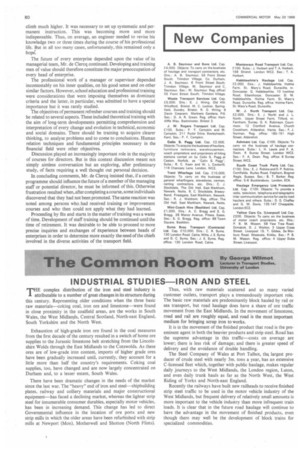The Common Room By George Wilmot
Page 82

If you've noticed an error in this article please click here to report it so we can fix it.
Lecturer in Transport Studies, University of London
INDUSTRIAL STUDIES-IRON AND STEEL
FriE complex distribution of the iron and steel industry is attributable to a number of great changes in its structure during this century. Representing older conditions when the three basic raw materials—coking coal, iron ore and limestone—were found in close proximity in the coalfield areas, are the works in South Wales, the West Midlands, Central Scotland, North-east England, South Yorkshire and the North West.
Exhaustion of high-grade iron ore found in the coal measures from the first decade of the century resulted in a switch of home ore supplies to the Jurassic limestone belt stretching from the Lincolnshire Wolds through the East Midlands to the Cotswolds. As these ores are of low-grade iron content, imports of higher grade ores have been gradually increased until, currently, they account for a little more than half the country's requirements. Coking coal supplies, too, have changed and are now largely concentrated on Durham and, to a lesser extent, South Wales.
There have been dramatic changes in the needs of the market since the last war. The "heavy" end of iron and steel—shipbuilding plates, railway and colliery materials and major constructional equipment—has faced a declining market, whereas the lighter strip steel for innumerable consumer durables, especially motor vehicles, has been in increasing demand. This change has led to direct Governmental influence in the location of ore ports and new strip mills in which the older areas have been refurbished with strip mills at Newport (Mon), Motherwell and Shotton (North Flints). Thus, with raw materials scattered and so many varied customer outlets, transport plays a tremendously important role. The basic raw materials are predominantly block hauled by rail or sea transport, but road haulage does have a share of ore traffic movement from the East Midlands. In the movement of limestone, road and rail are roughly equal, and road is the most important medium for bringing scrap iron to works.
It is in the movement of the finished product that road is the preeminent agent in both the heavier products and strip steel. Road has the supreme advantage in this traffic—costs on average are lower; there is less risk of damage; and there is greater speed of delivery and the avoidance of double handling_ The Steel Company of Wales at Port Talbot, the largest producer of crude steel with nearly 3m. tons a year, has an extensive C -licensed fleet which, together with public haulage, makes regular daily journeys to the West Midlands, the London region, Luton, and even daily trunk hauls as far as the North West, the West Riding of Yorks and North-east England.
Recently the railways have built new railheads to receive finished strip steel traffic to be used in the motor vehicle industry of the West Midlands, but frequent delivery of relatively small amounts is more important to the vehicle industry than more infrequent train loads. It is clear that in the future road haulage will continue to have the advantage in the movement of finished products, even though there may well be the development of block trains for specialized commodities.




























































































































